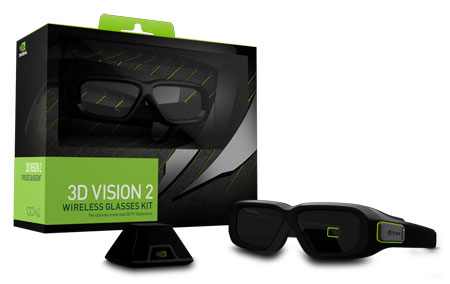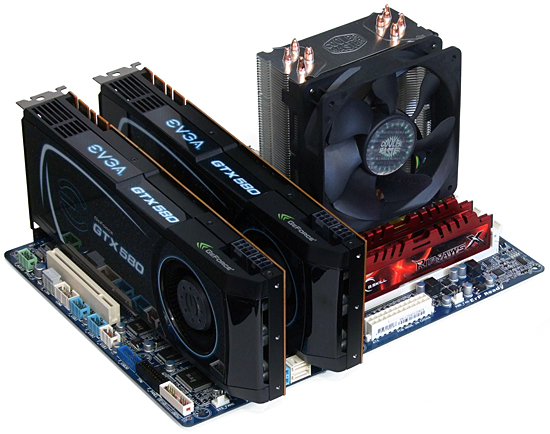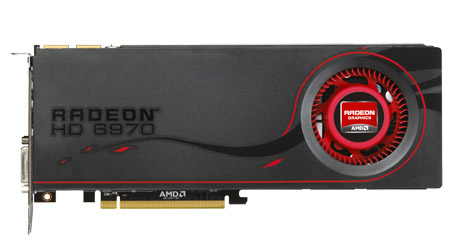Stereo Shoot-Out: Nvidia's New 3D Vision 2 Vs. AMD's HD3D
Nvidia just updated its stereoscopic 3D ecosystem with 3D Vision 2. We show you what makes this initiative different and how it compares to the competition. Then, we benchmark GeForce and Radeon graphics cards in a no-holds-barred stereo showdown!
GeForce 3D Vision Vs. HD3D: Another Close Race
This article addresses both Nvidia’s new 3D Vision 2 technology, along with the performance implications of 3D Vision versus AMD HD3D. Let's consider each focus independently.
3D Vision 2
We'll start with 3D Vision. With brighter LED-backlit monitors, more aggressive timings, and upgraded glasses, 3D Vision 2 is a much-needed fix for our biggest complaint about the original version: everything appeared too dark. With the hardware upgrades, content on-screen and items off-screen are far easier to see, and you no longer have to turn off the lights to play games. In addition, the new, larger glasses are a bit more affordable, and that’s always a good thing.
On the other hand, Nvidia has new competition from Samsung’s new 750- and 950-series 3D monitors, products that frankly put Nvidia’s original 2.5+ year-old standard to shame when it comes to brightness and display quality. In addition, Samsung is being aggressive with its pricing of monitors and 3D glasses.
The bottom line: Nvidia needed a 3D Vision update in order to keep the products in its ecosystem competitive with some of the technologies emerging with support for AMD's own initiative, and we're glad to see the response.
Nvidia 3D Vision 2 vs. AMD HD3D Stereoscopic Performance
A lot of people (myself included) assumed that the extra load applied by rendering in stereo would almost require a dual-card graphics configuration, and that AMD's lack of support for CrossFire would be a huge detriment in this regard. Surprise: that doesn’t seem to be the case.
Get Tom's Hardware's best news and in-depth reviews, straight to your inbox.
Yes, the GeForce GTX 580 SLI setup wins all of the benchmarks we run, but the Radeon HD 6970 gets surprisingly close (particularly when anti-aliasing isn't applied). There are two factors at work here: a 60 FPS frame rate limit imposed by rendering in stereo, and a relatively low 1080p maximum resolution shared by 3D monitors. With these restrictions in place, Nvidia’s SLI technology doesn’t have much room to strut it’s stuff. Conversely, the Radeon HD 6970 seems just about right-sized to handle 1920x1080 at the performance levels needed to make gaming in stereo playable.
But there’s more to the story: anti-aliasing. Running a pair of high-end cards in SLI seems to be the only way to push enough performance for 4x MSAA across the board, and the only game that forces two GTX 580s under 50 FPS at 1080p is Metro 2033. Even in this cruelly-demanding title with anti-aliasing enabled, this duo of flagships musters 47 FPS. Contrast that with the TriDef driver’s complete inability to handle MSAA in Virtual 3D mode. The default TriDef 3D mode only supports MSAA on rare occasions, leaving AMD’s morphological AA to be the closest thing to a dependable solution. We’ll take MSAA over MLAA any day of the week, and AMD's morphological solution really puts a hurt on performance. This is HD3D's Achilles' heel.
There's one more thing to consider: multi-monitor support. If you're looking for the ultimate 3D experience and absolutely stoked about throwing money at evolving technology, there's always the option to purchase a triple-monitor setup for more immersive stereoscopic 3D. At the ultra-high resolutions demanded by 3D Surround and Eyefinity, multiple graphics cards are a must. Granted, this is a niche setup. But it's an obvious win for Nvidia and SLI until AMD can deliver a CrossFire-capable HD3D driver.
The bottom line is, Nvidia has an undeniable advantage with SLI support, especially when anti-aliasing is considered. Nevertheless, AMD’s Radeon HD 6970 should not be discounted, as it musters at least 45 FPS at 1080p in every game we tested, as long as AA is disabled. As far as lesser cards like the GeForce GTX 550 Ti and Radeon HD 6790 are concerned, skip over them entirely if you’re serious about putting together a stereoscopic 3D gaming rig.
Final Thoughts
If you were hoping for a definitive winner in this match-up, we're almost happy to say that there is none. Almost. It's not a clear-cut competition, to begin, as both AMD and Nvidia still have significant issues that would keep any gaming from being completely satisfied. This is a complicated issue and there are no easy answers.
As we mentioned in our previous review, certain games remain completely unplayable on one solution or the other. Enthusiasts interested in dabbling with 3D are forced to include their favorite titles as they calculate which standard to adopt. The good news is that both 3D Vision and HD3D are viable, and there are excellent displays available, no matter which one you choose.
If you’ve made the decision to try stereoscopic 3D, but you’re struggling to find information on what games work best with 3D Vision and HD3D, you may want to check out the GameGrade3D database. This is a new evaluation system from MTBS3D.com, an independent stereoscopic 3D advocacy group. It seems they’ve taken our concerns about possible confusion caused by their previous rating system to heart, recently adopting a rating system that features separate indicators for visual quality and 3D controls. To us, this seems like a very promising way to rate a 3D gaming experience, and we look forward to seeing their final product. The beta version of this new stereoscopic 3D game rating system is scheduled to go live on October 17th at www.gamegrade3d.com.
Current page: GeForce 3D Vision Vs. HD3D: Another Close Race
Prev Page Benchmark Results: World Of WarcraftDon Woligroski was a former senior hardware editor for Tom's Hardware. He has covered a wide range of PC hardware topics, including CPUs, GPUs, system building, and emerging technologies.
-
airborne11b I didn't see any mention of crosstalk *3D GHOSTING* in this article.Reply
Does this new nvidia vision 2 really reduce crosstalk? He'll it's even listed on the promotion of the product
http://media.bestofmicro.com/7/X/311325/original/Third%20Generation%203D%20Monitors.JPG
Yet I saw no mention of it in this article. Any word on how well it handles cross talking / 3D ghosting would be appreciated. -
de5_Roy the glasses look kinda dorky.. still waiting for glasses-free 3d. i'd rather use a 120 hz monitor instead of eye-hurting 60 hz ones (without 3d).Reply -
bystander It would appear that virtual 3D mode takes a lot less power to render a single image and extrapolate the other eyes image than it is to render two images independently in normal mode. This appears to be the only reason it does compete without crossfire support. This is both good and bad. It works in almost all situations, but never at great visual quality.Reply
I'd also like to point out that the lack of AA is not a big deal in 3D. I find I don't notice the same issues without AA in 3D. When the mind fuses two images together, it's not as bothered by AA. -
airborne11b greghomeIMO, 3D is still not as appealing and no as cheap as Eyefinity or 2D Vision Tri-Screen Gaming.Reply
I'm a fan of both 3x monitor set ups, but 3D is a lot cooler.
Problem with 3x monitors is the fish-eye effect that's very disturbing (and not fixable) in landscape mode. The best you can do with 3x monitors is use expensive 1920 x 1200 IPS monitors in portrait mode, but in this set up the bezels are normally cutting right through game HUDs / hotkey bars and puts the bezels far too close to your center of view.
Further more, for this kind of Eyefinity/Nvidia surround monitor set up, costs about $1200 - $1500. (Or even more expensive projector set ups that require a ton of space and cost as much or more if you want to try and get rid of the bezels)
Now consider Nvidia 3D. It adds amazing depth and realism to the games over 2D, doesn't have a negitive "fish eye effect", no bezels to deal with, same GPU power requirements as 3x monitors (or less), doesn't interrupt game huds or hotbars and only costs about $600-700 for the most expensive 27" screen + glasses combos. (even cheaper with smaller monitors.
The clear choice is 3D imo.
But 3x monitors is still much better then single 2D monitor. I rocked 5760 x 1080 in BFBC2, Aion and L4D for a long time :P.
3D is cooler though. -
billcat479 It seems people don't follow the news on this area very much. It's not sounding all that great.Reply
I guess most people haven't read that people using 3D tv's have been getting headaches and it's not a few but a lot of people.
They should have left it in the theaters.
I wouldn't be surprised to find if and when they do a good long term study of people using them long term in gaming start to have long term medical problems if or when they get around to doing good studies on the topic. I have read enough to stay away from this 3D glasses hardware. At best I'd only use it very little and for short term use.
They really do need to do medical testing on this because people are being effected by prolonged use of 3D glasses with tv. Add all day video gaming and I think there is a possibility small or large of long term or perm. damage to people. They dumped this on the market pretty fast without doing any studies that I know of but with the amount of people showing headaches I think it is getting more attention or should damm well start checking out the possibility of any chance of eye damage or worse.
Eyesight is pretty useful.
If they ever get a holographic display then I'd be into it.
-
amk-aka-Phantom Dirt 3, first benchmark: 6790 and 6970 should switch places! Right now 6790 is performing 5 times as good as the 6970 :D Fix that, please.Reply -
CaedenV @billcatReply
So shutter tech which has been around some 15 years is dangerous, but holographic tech which isn't really available yet would be good? I would think you would want to exercise caution with any new optical tech. Personally I am allergic to the laser-to-eye theory of hologram tech.
As for the article, it was a great review! Looks like the tech is still too high end for my budget, but I am sure they will iron out all the kinks by the time I am ready to replace my monitor (which wont be soon as I love the thing). I am really curious about how the next gen graphics cards will improve in this area! Cant wait for those reviews! -
airborne11b billcat479It seems people don't follow the news on this area very much. It's not sounding all that great. I guess most people haven't read that people using 3D tv's have been getting headaches and it's not a few but a lot of people. They should have left it in the theaters. I wouldn't be surprised to find if and when they do a good long term study of people using them long term in gaming start to have long term medical problems if or when they get around to doing good studies on the topic. I have read enough to stay away from this 3D glasses hardware. At best I'd only use it very little and for short term use. They really do need to do medical testing on this because people are being effected by prolonged use of 3D glasses with tv. Add all day video gaming and I think there is a possibility small or large of long term or perm. damage to people. They dumped this on the market pretty fast without doing any studies that I know of but with the amount of people showing headaches I think it is getting more attention or should damm well start checking out the possibility of any chance of eye damage or worse. Eyesight is pretty useful. If they ever get a holographic display then I'd be into it.Reply
This is the kind of uninformed, ignorant posts that irritate me. Interweb wanna be docs who don't know how the human body works. Allow me to educate you.
People used to say that "reading a book in the dark" or watching TV or normal PC monitor "too close" would "damage your eyes". In fact we know today that eye sight degeneration has a few factors, none of which are from normal straining.
The most common cause of eye sight degeneration is Presbyopia (from the normal aging process, where the lens progressively loses its capacity to increase its power for near vision)
Also, UV rays degenerate tissue so it's recommended you way UV protective sunglasses when outside in daylight. UV rays can cause your eyesight to weaken over time.
Also refractive error(Common in people ALL ages): A condition may be either because the eye is too short or long in length, or because the cornea or lens does not have the required refractive power. There are three types of refractive errors which are Myopia (near-sight), Hypermetropia (long-sight) and Astigmatism which is the condition where the eye does not focus the light evenly, usually due to the cornea of the eye being more curved in one direction than the other. It may occur on its own or may be associated with myopia or hypermetropia.
The very worst thing that 3D vision can do in terms of negitive health effects, is the same EXACT effects of reading too much, IE; an extremely short term headache. To cure the headache TAKE A BREAK.
Also, as you build tolerance to 3D vision (As I have just after a week or 2 of consistent use) the headaches go away. Also Nvidia 3D settings allow you to adjust the depth of the 3D, less depth = less strain and you can progressively increase 3D as you build tolerance to the use of 3D monitors.
In closing, don't post nonsense about what you don't understand. It makes you look stupid. -
oneseraph I normally don't chime in however in this case I just have to say "Who Cares"? Every time I see an article about 3D graphics and 3D display tech there are always excuses for the technology not being ready. Did I misunderstand or did this article point out that neither Nvidia or AMD have a ready for prime time product. So why are they releasing this crap to us consumers and calling it a feature? When the truth is it Tech that still belongs in the lab. Come on, if you bought a blender that would blend strawberries but would not work if you put bananas in it you not only return the item but in all likelihood there would be a class action suite against the manufacturer. In short for right now 3D is just not ready. The marketing departments of both Nvidia and AMD are being more than a little dishonest about they're respective 3D features. There are lots of good reasons to buy a new graphics card. Just don't be fooled into thinking that 3D is one of them.Reply



